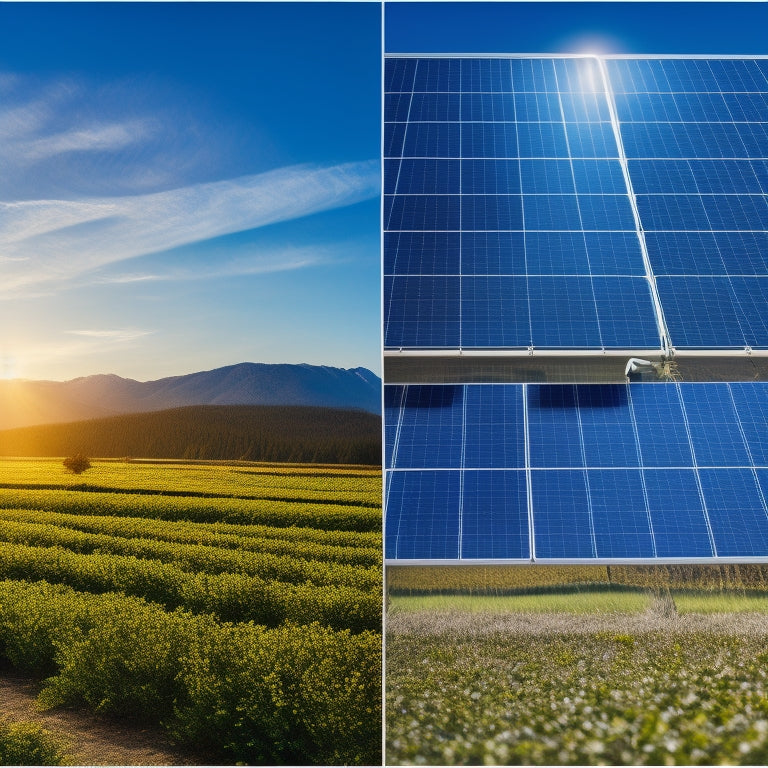
10 Key Trends and Stats on the Price of Solar Cells
Share
You've seen solar cell prices plummet by over 80% since 2010, driving a surge in demand and adoption across residential, commercial, and utility-scale sectors. A significant decline in solar cell costs is attributed to economies of scale, technological advancements, and intense price wars among manufacturers. Government incentives have also played a significant role, with the US Solar Investment Tax Credit reducing solar energy costs by approximately 70%. As you investigate the solar cell market, you'll find that average efficiencies have reached 20%, thin-film solar cells have emerged as cost-effective alternatives, and China dominates global production. There's more to unveil in this rapidly changing industry.
Key Takeaways
- Global average price of solar cells has decreased by over 80% since 2010, with an average reduction of approximately 82% over the past decade.
- Market competition is expected to continue driving prices lower, with projections indicating a decrease of 12-15% in module prices by 2029.
- Government incentives such as subsidies, tax credits, and investment incentives have significantly influenced solar cell market prices, fostering competition.
- Average efficiency of commercial solar panels is now around 20%, with innovations in materials contributing to efficiency improvements and cost reductions.
- Continued downward price trends are expected due to technological advancements, global competition, and consumer adoption driving economies of scale.
Historical Decline in Solar Cell Costs
More than 70% of the total cost of a solar panel system is attributed to the solar cells themselves. You might assume that this significant cost component would remain unchanged, but that's not the case.
Over the past decade, you've witnessed an extraordinary decline in solar cell costs, driven primarily by market fluctuations and technological advancements.
As manufacturers scaled up production to meet growing demand, economies of scale kicked in, reducing production costs. Meanwhile, researchers continued to improve manufacturing processes, leading to higher efficiencies and lower costs per unit.
These advancements have led to a dramatic drop in solar cell prices, making solar energy more competitive with fossil fuels.
This trend shows no signs of slowing down. As the industry continues to innovate and mature, you can expect further reductions in solar cell costs.
This downward path has significant implications for the adoption of solar energy, making it an increasingly viable option for those seeking to utilize the power of the sun.
Global Solar Cell Price Averages
The global average price of solar cells has plummeted over the years, with a steady decline observed since 2010. You've likely seen this trend play out in the market, with prices dropping by over 80% in the last decade. This downward path is largely driven by global market forces, including economies of scale, improved manufacturing efficiency, and increased competition.
As you explore deeper into the data, you'll notice regional price variations. For instance, the average price of solar cells in the Asia-Pacific region is considerably lower than in North America or Europe. This is largely due to the concentration of manufacturers in countries like China, where labor and production costs are lower.
In contrast, regions with higher labor and material costs tend to have higher average prices.
Understanding these regional price variations is vital for investors, policymakers, and industry professionals looking to capitalize on the growing demand for solar energy. By staying ahead of the curve on global solar cell price averages, you can make more informed decisions about your investments, projects, and policies.
Impact of Government Incentives
Government incentives have played a significant role in shaping the solar cell market, particularly when it comes to prices. You've likely benefited from these incentives, which have led to a significant decrease in solar cell prices over the years.
Government subsidies, tax credits, and investment incentives have encouraged market competition, driving innovation and reducing production costs. As a result, you've seen a decline in the average cost of solar cells.
In the United States, for instance, the Solar Investment Tax Credit (ITC) has been instrumental in promoting the adoption of clean energy. Policy structures like the ITC have increased public awareness about renewable energy, leading to higher demand and lower prices.
According to the National Renewable Energy Laboratory, the ITC has helped reduce the cost of solar energy by approximately 70% over the past decade. These incentives have made solar energy more competitive with fossil fuels, clearing the path for a cleaner, more sustainable future.
Rise of Thin-Film Solar Cells
You're now looking at thin-film solar cells, which have emerged as cost-effective alternatives to traditional photovoltaic technologies.
These cells have made significant efficiency gains, with average conversion rates increasing by over 10% in the past five years alone.
As you investigate this trend, you'll see how thin-film solar cells are changing the game for solar panel manufacturers and consumers alike.
Cost-Effective Alternatives
As silicon wafer prices plummeted, thin-film solar cells emerged as a viable alternative, offering a cheaper and more efficient solution for utilizing solar energy.
You're likely to benefit from this shift, especially if you're considering community solar projects or solar leasing options.
Thin-film solar cells use minimal material, reducing production costs by up to 50%. This translates to a lower cost per watt, making solar energy more accessible to a broader audience.
With thin-film technology, you can expect a higher energy yield per unit area, resulting in more power generated from a smaller installation.
Additionally, thin-film solar cells are more flexible and durable, allowing for a wider range of applications.
As you weigh your options, consider the long-term benefits of thin-film solar cells, including reduced maintenance costs and increased energy production.
Efficiency Gains
Thin-film solar cells have transformed the solar industry by achieving extraordinary efficiency gains, thanks to advancements in technology and manufacturing processes. As you investigate the market, you'll notice that these cells have become increasingly competitive with traditional crystalline silicon-based solar cells.
The enhancement in efficiency is largely attributed to improved deposition techniques, enhanced material quality, and optimized device designs.
You'll see that the rise of thin-film solar cells has led to a significant reduction in production costs. This, in turn, has intensified market competition factors, driving prices down across the industry.
According to recent data, the average efficiency of thin-film solar cells has increased by over 10% in the last five years, with some models reaching efficiencies as high as 23.2%.
As you probe deeper into the world of solar technology advancements, you'll realize that thin-film solar cells aren't only more efficient but also more cost-effective.
With ongoing research and development, experts predict that thin-film solar cells will continue to dominate the market, further reducing prices and increasing adoption rates.
Solar Cell Efficiency Improvements
The efficiency of solar cells has increased dramatically over the years, with the average commercial solar panel now boasting an efficiency rate of around 20%.
You're likely aware that this surge is largely attributed to advancements in solar cell materials and manufacturing innovations. Researchers have been experimenting with novel materials like perovskite and bifacial solar cells, which have shown promising results in efficiency testing.
To quantify these gains, performance metrics such as power conversion efficiency (PCE) and fill factor (FF) are used to evaluate solar cell performance.
As market competition intensifies, manufacturers are adopting sustainable practices to reduce waste and energy consumption. In addition, research funding and technology partnerships have accelerated the development of more efficient solar cells.
For instance, the US Department of Energy's SunShot Initiative has been instrumental in driving innovation in solar cell technology.
As you investigate the solar energy environment, you'll find that these advancements have significant implications for the industry's growth and adoption.
Price War Among Manufacturers
You're likely to notice a direct correlation between the surge in solar cell efficiency and the subsequent drop in prices. This downward trend is largely attributed to the intense price war among manufacturers. As companies compete for market share, they're forced to adopt aggressive pricing strategies, driving costs down.
Market consolidation has also played a significant role, as larger manufacturers acquire smaller ones, leveraging production scalability to reduce expenses.
Technology innovations have further accelerated this trend, enabling manufacturers to produce high-quality solar cells at lower costs. Improved supply chain interactions, coupled with increased consumer awareness, have created an environment where manufacturers must prioritize quality standards while keeping prices competitive.
Tariff implications have added complexity to this arena, but investment trends suggest that manufacturers are adapting and finding ways to maintain profitability.
As you analyze the price war among manufacturers, it's clear that this competitive environment has been instrumental in driving down solar cell prices, making renewable energy more accessible to consumers.
Shift to Bifacial Solar Cells
You're likely familiar with the traditional single-sided solar cells, but now you're witnessing a significant shift towards bifacial solar cells.
These advanced modules can utilize energy from both the front and back sides, promising improved performance and reduced costs.
As you investigate this trend, you'll uncover the advantages of bifacial tech, expected efficiency gains, and the potential for cost reductions.
Bifacial Tech Advantages
Frequently, solar panel manufacturers are shifting their focus towards bifacial solar cells, and for good reason. Bifacial tech offers several advantages that make it an attractive option for utilizing solar energy. For one, bifacial solar cells can generate energy from both the front and back sides of the panel, increasing overall energy output. This is particularly useful for bifacial applications where the rear side of the panel can capture reflected light, such as in rooftop or desert installations.
| Bifacial Advantage | Description |
| Increased Energy Yield | Up to 25% more energy generated from rear side |
| Improved Low-Light Performance | Enhanced energy output in low-irradiance conditions |
| Reduced LCOE | Lower levelized cost of energy due to increased output |
| Enhanced Durability | Bifacial cells show improved resistance to environmental stressors |
Efficiency Gains Expected
Optimization is the driving force behind the solar industry's shift towards bifacial solar cells, as manufacturers strive to squeeze every last watt out of their panels.
You're likely to see significant efficiency gains in the coming years, driven by market competition and technological innovations. Bifacial cells, with their ability to capture energy from both the front and back sides, are set to become the new standard.
As you investigate the latest advancements, you'll notice that bifacial cells are already demonstrating higher efficiencies than their monofacial counterparts.
According to recent studies, bifacial cells can increase energy output by up to 25% compared to traditional monofacial cells. This increase in efficiency is expected to lead to higher power output per unit area, ultimately reducing the levelized cost of energy (LCOE) for solar power plants.
As the industry continues to expand the limits of what's possible, you can expect to see even more innovative designs and materials emerge.
With the global solar market becoming increasingly competitive, manufacturers are under pressure to deliver higher-performing products at lower costs. This drive for efficiency will certainly lead to even more exciting developments in the world of solar cells.
Cost Reduction Potential
The shift to bifacial solar cells is ready to release significant cost reduction potential for solar power plants. You're likely wondering how this shift will impact the industry. The answer lies in the numbers.
| Cost Reduction Driver | Current Status | Projected Impact |
|---|---|---|
| Supply Chain Optimizations | 5-7% reduction in material costs | 10-12% reduction by 2025 |
| Manufacturing Innovations | 10-12% reduction in production costs | 15-18% reduction by 2027 |
| Market Competition | 8-10% reduction in module prices | 12-15% reduction by 2029 |
As you can see, the shift to bifacial solar cells is expected to drive down costs across the supply chain, manufacturing, and market competition. These reductions will have a ripple effect, leading to decreased installation costs and increased consumer adoption. Additionally, technological advancements in energy storage and grid integration will also contribute to the overall cost reduction potential. With recycling initiatives and resource scarcity mitigation strategies in place, the industry is prepared for significant growth and adoption.
China's Dominance in Solar Cell Production
You're likely aware that China has emerged as the undisputed leader in solar cell production, accounting for over 70% of the world's total solar cell output. This dominance is attributed to several factors.
-
China's large-scale production capacity enables it to capitalize on economies of scale, reducing costs and increasing efficiency.
-
The country's well-established supply chain and infrastructure support the production process, ensuring timely delivery and quality control.
-
China's significant research investment and policy influence have driven technological innovations, allowing it to stay ahead of the competition.
- Additionally, the government's emphasis on environmental standards and workforce development has attracted foreign investment, further solidifying China's position in the solar cell market.
China's dominance has led to a significant increase in exports, with the country supplying solar cells to major markets worldwide.
This has intensified market competition, forcing other manufacturers to adapt and improve their production processes to remain competitive.
As a result, China's dominance in solar cell production is expected to continue, shaping the industry's future.
Increase in Solar Cell Demand
As China's dominance in solar cell production continues to shape the industry, a concurrent trend is emerging: a significant increase in solar cell demand.
You're witnessing a surge in demand driven by market drivers such as declining costs, favorable government policies, and growing consumer awareness about environmental benefits.
Installation trends indicate that residential and commercial sectors are leading the charge, with utility-scale adoption also on the rise.
Technological innovations have improved efficiency and reduced costs, making solar energy more competitive with fossil fuels.
Regional differences persist, with countries like the US, India, and Australia experiencing rapid growth.
Financing options, such as power purchase agreements and community solar programs, have increased accessibility.
As a result, you're seeing increased adoption across various demographics.
With the industry ready for continued growth, it's crucial to understand the factors driving this demand surge.
Future Projections for Solar Cell Prices
As you look to the future of solar cell prices, several factors will influence the market, primarily driven by advancements in technology and economies of scale. You can expect prices to continue their downward trend, making solar energy even more competitive with fossil fuels.
Some key factors that will shape the future of solar cell prices include:
-
Market trends: Global competition and increasing consumer adoption will drive demand, leading to further economies of scale and lower prices.
-
Technology advancements: Future innovations in solar cell design, materials, and manufacturing processes will improve efficiency and reduce costs.
-
Investment opportunities: Governments and private investors will continue to pour money into research developments, driving progress in solar technology and reducing prices.
- Supply chain and recycling solutions: As the industry grows, more efficient supply chains and recycling solutions will emerge, reducing waste and costs.
With policy changes and research developments on the horizon, the future of solar cell prices looks bright. You can expect prices to continue falling, making solar energy an increasingly viable option for power generation.
Frequently Asked Questions
What Is the Average Lifespan of a Solar Cell Module?
You can expect a solar cell module to last around 30 years, with a gradual decline in solar cell efficiency. By following proper maintenance practices, you'll guarantee peak performance and extend its lifespan, maximizing your clean energy output.
Can Solar Cells Be Recycled at the End of Their Life?
You'll be pleased to know that solar cells can be recycled at the end of their life, enabling efficient end-of-life management through solar cell recycling, which helps recover precious materials like silicon and metals.
How Do Solar Cells Perform in Extreme Weather Conditions?
You'll find that solar cells perform impressively in extreme weather conditions, boasting exceptional durability and extreme weather resilience, withstanding scorching temperatures, torrential rains, and powerful winds, ensuring a consistent power supply that meets your energy demands.
Are There Any Alternative Materials to Silicon in Solar Cells?
You're exploring alternatives to silicon in solar cells, and you'll find organic photovoltaics and perovskite cells are gaining traction, offering potential efficiency enhancements and lower production costs, although their stability and scalability remain areas for improvement.
Can Solar Cells Be Used to Power Electric Vehicles Directly?
Ha! You think solar cells can directly power your electric vehicle? Dream on! But, technically, if you're willing to sacrifice speed, solar cell efficiency can facilitate direct charging, albeit at a snail's pace of 1-2 miles per hour.
Conclusion
You've now got an extensive summary of the current state of solar cell prices. One striking statistic: did you know that the cost of solar cells has plummeted by a staggering 82% over the past decade? As the industry continues to evolve, it's likely that prices will drop even further. With demand on the rise and new technologies emerging, the future of solar energy looks brighter than ever.
Related Posts
-

Integrating Solar Panels Into Home Design
Integrating solar panels into your home design greatly enhances energy efficiency and lowers utility bills while addi...
-

Long-Term Cost Savings With Solar Panels
Investing in solar panels offers substantial long-term savings on energy costs. You'll benefit from federal tax credi...
-

Passive Solar Design Strategies for Homes
To effectively implement passive solar design strategies in your home, focus on ideal building orientation and strate...


